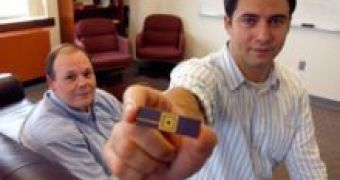A team of scientists at the University of Rochester has announced a breakthrough in the field of imaging chips.
Mark Bocko, professor of electrical and computer engineering, and Zeljko Ignjatovic, assistant professor of electrical and computer engineering, have designed a prototype chip that can digitize an image right at each pixel, and they are working now to incorporate a second technology that will compress the image with far fewer computations than the best current compression techniques.
"These two technologies may work together or separately to greatly reduce the energy cost of capturing a digital image," says Bocko. "One is evolutionary in that it pushes current technology further. The second may prove to be revolutionary because it's an entirely new way of thinking about capturing an image in the first place."
The first technology being developed integrates an oversampling "sigma-delta" analog-to-digital converter at each pixel location in a CMOS sensor. Previous attempts to do this on-pixel conversion have required far too many transistors, leaving too little area to collect light.
The new designs use as few as three transistors per pixel, reserving nearly half of the pixel area for light collection. First tests on the chip show that at video rates of 30 frames per second it uses just 0.88 nanowatts per pixel, 50 times less than the industry's previous best.
It also trounces conventional chips in dynamic range, which is the difference between the dimmest and brightest light it can record. Existing CMOS sensors can record light 1,000 times brighter than their dimmest detectable light, a dynamic range of 1:1,000, while the Rochester technology already demonstrates a dynamic range of 1:100,000.
The second advance has taken many researchers by surprise. Called "Focal Plane Image Compression," Bocko and Ignjatovic have figured out a way to arrange photodiodes on an imaging chip so that compressing the resulting image demands as little as 1 percent of the computing power usually needed.
The team members are now looking to build a prototype chip that incorporates both technologies into a single unit to see how much real-world processing power the designs will save. They plan to integrate the technology into wireless security cameras at first.
Photo Credit: University of Rochester

 14 DAY TRIAL //
14 DAY TRIAL //